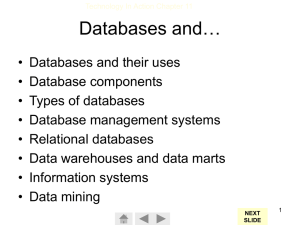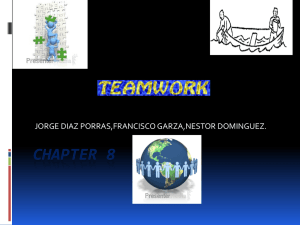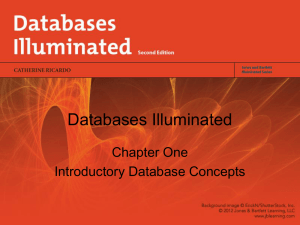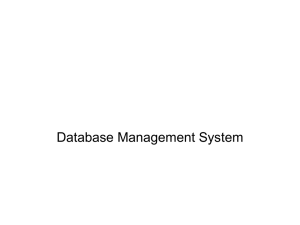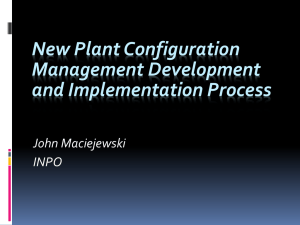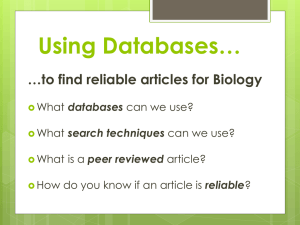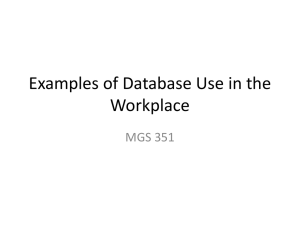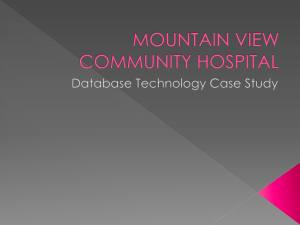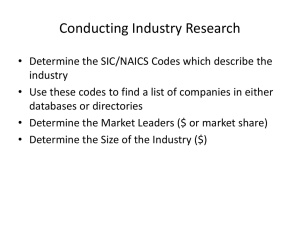Chapter 8
advertisement
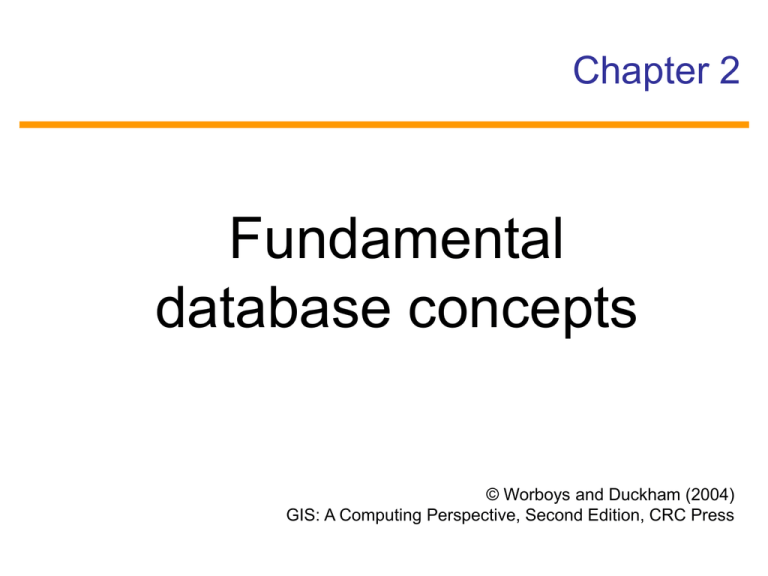
Chapter 2 Fundamental database concepts © Worboys and Duckham (2004) GIS: A Computing Perspective, Second Edition, CRC Press What you will learn Summary Summary Introduction to databases Relational databases Database development Object orientation • • • • What is a database? Why use a database? What is a relational database? Why does spatial data present problems for relational databases? • How do you develop a database? • What is object-orientation, and how is it relevant to databases? © Worboys and Duckham (2004) GIS: A Computing Perspective, Second Edition, CRC Press Section 2.1 Introduction to databases © Worboys and Duckham (2004) GIS: A Computing Perspective, Second Edition, CRC Press What is a database? Summary Introduction Introduction to databases databases to Relational databases Database development Object orientation • A database is a collection of data organized in such a way that a computer can efficiently store and retrieve data – A repository of data that is logically related • A database is created and maintained using a general-purpose piece of software called a database management system (DBMS) © Worboys and Duckham (2004) GIS: A Computing Perspective, Second Edition, CRC Press The database approach Summary Introduction Introduction to databases databases to Relational databases Database development Object orientation • Before databases, computers were primarily used to convert data between different formats – “The computer as a giant calculator” • Databases treat computers as useful repositories of data – “The computer as data repository” • Most applications (including GIS) require a balance of processing and storage © Worboys and Duckham (2004) GIS: A Computing Perspective, Second Edition, CRC Press Databases in a nutshell Summary Introduction Introduction to databases databases to Relational databases Database development Object orientation • In order to be effective, databases must offer the following functions: – – – – – Reliability Integrity Security User views User interface – – – – Data independence Self-describing Concurrency Distributed capabilities – High performance • All these functions are managed by the DBMS © Worboys and Duckham (2004) GIS: A Computing Perspective, Second Edition, CRC Press Nutty Nuggets #1 Summary Introduction Introduction to databases databases to Relational databases Database development Object orientation • We might write a program to organize the stock for the “Nutty Nuggets” restaurant • As time continues, this program will become more complex, offering more functions Stage 1 Stage 2 © Worboys and Duckham (2004) GIS: A Computing Perspective, Second Edition, CRC Press Nutty Nuggets #2 • Key problems with the previous approach are: Summary Introduction Introduction to databases databases to – Loss of integrity – Loss of independence – Loss of security • Stage 3, the database, solves these problems Relational databases Database development Object orientation Stage 3 © Worboys and Duckham (2004) GIS: A Computing Perspective, Second Edition, CRC Press Common database applications • Home/office database – Simple applications (e.g., Nutty Nuggets) Summary Introduction Introduction to databases databases to Relational databases Database development Object orientation • Commercial database – Store the information for businesses (e.g. customers, employees) • Engineering database – Used to store engineering designs (e.g. CAD) • Image and multimedia database – Store image, audio, video data • Geodatabase – Store a combination of spatial and non-spatial data © Worboys and Duckham (2004) GIS: A Computing Perspective, Second Edition, CRC Press Elements of a DBMS Summary Introduction Introduction to databases databases to Relational databases Database development Object orientation • Query language • Query compiler • Runtime database processor • Constraint enforcer • Stored data manager • System catalog/data dictionary © Worboys and Duckham (2004) GIS: A Computing Perspective, Second Edition, CRC Press Transaction management • A transaction is an atomic unit of interaction between user and database Summary Introduction Introduction to databases databases to Relational databases Database development Object orientation – – – – Insertion of data Modification of data Deletion of data Retrieval of data • Transaction management must support – Concurrency (multiple users accessing the same data at the same time) – Recovery management (retrieval of a valid database state following system failure) © Worboys and Duckham (2004) GIS: A Computing Perspective, Second Edition, CRC Press Concurrency: Lost update Summary • Lost update can occur when atomic transactions are incorrectly interleaved Introduction Introduction to databases databases to Relational databases Database development Object orientation © Worboys and Duckham (2004) GIS: A Computing Perspective, Second Edition, CRC Press Section 8.2 Relational databases © Worboys and Duckham (2004) GIS: A Computing Perspective, Second Edition, CRC Press Database architectures • Most databases today are either: Summary Introduction to databases Relational Relational databases databases Database development Object orientation – Relational; or – Object-oriented (especially useful for spatial data) • Early database systems were based on the hierarchical model – Efficient storage, but limited expressiveness • The network model was used to overcome lack of expressiveness in hierarchical databases – But led to highly complex database system • The deductive model is an active research area today – Stores rules in addition to facts © Worboys and Duckham (2004) GIS: A Computing Perspective, Second Edition, CRC Press The relational model Summary Introduction to databases Relational Relational databases databases Database development Object orientation • A relational database is a collection of relations, often just called tables • Each relation has a set of attributes • The data in the relation is structured as a set of rows, often called tuples • Each tuple consists of data items for each attribute • Each cell in a tuple contains a single value • A relational database management system (RDBMS) is the software that manages a relational database © Worboys and Duckham (2004) GIS: A Computing Perspective, Second Edition, CRC Press Example relation Relation Attribute Summary Introduction to databases Relational Relational databases databases Database development Object orientation Tuple Data item © Worboys and Duckham (2004) GIS: A Computing Perspective, Second Edition, CRC Press Relations Summary Introduction to databases Relational Relational databases databases Database development Object orientation • A relation scheme is the set of attribute names and the domain (data type) for each attribute name • A database scheme is a set of relation schemes • In a relation: – Each tuple contains as many values as there are attributes in the relation scheme – Each data item is drawn from the domain for its attribute – The order of tuples is not significant – Tuples in a relation are all distinct from each other • In most relational systems, data items are atomic – A relation that contains only atomic items is said to be in first normal form (1NF) • The degree of a relation is its number of columns • The cardinality of a relation is the number of tuples © Worboys and Duckham (2004) GIS: A Computing Perspective, Second Edition, CRC Press Relation scheme Summary Introduction to databases Relational Relational databases databases • A candidate key is an attribute or minimal set of attributes that will uniquely identify each tuple in a relation • One candidate key is usually chose as a primary key Database development Object orientation © Worboys and Duckham (2004) GIS: A Computing Perspective, Second Edition, CRC Press Operations on relations Summary Introduction to databases Relational Relational databases databases Database development Object orientation • There are five fundamental relational operators: union, difference, product, project, and restrict • Three derived relational operators are also important: intersection, divide, and join • Together, these operations and the way they are combined is called relational algebra combined • The relational model is said to be closed, because relational operators take one or more relations as input and return a relation © Worboys and Duckham (2004) GIS: A Computing Perspective, Second Edition, CRC Press Project operator • The project operator is unary Summary Introduction to databases Relational Relational databases databases – It outputs a new relation that has a subset of attributes – Identical tuples in the output relation are coalesced Database development Object orientation project NAME © Worboys and Duckham (2004) GIS: A Computing Perspective, Second Edition, CRC Press Restrict and join operators • The restrict operator is unary Summary Introduction to databases Relational Relational databases databases Database development Object orientation – It outputs a new relation that has a subset of tuples – A condition specifies those tuples that are required • The join operator is binary – It outputs the combined relation where tuples agree on a specified attribute (natural join) • Join is the most time-consuming of all relational operators to compute – In general, relational operators may not be arbitrarily reordered – Query optimization aims to find an efficient way of processing queries, for example reordering to produce equivalent but more efficient queries © Worboys and Duckham (2004) GIS: A Computing Perspective, Second Edition, CRC Press Relational operator example Summary Join relations SHOW and FILM using FILM_NAME and TITLE Introduction to databases Relational Relational databases databases Database development Object orientation Restrict using CINEMA_ID=1 Project TITLE, DIRECTOR, CINEMA_ID, and SCREEN_NO For full database see book web site: http://worboys.duckham.org © Worboys and Duckham (2004) GIS: A Computing Perspective, Second Edition, CRC Press Relational databases and spatial data • Several issues prevent unmodified databases being useful for spatial data Summary Introduction to databases Relational Relational databases databases Database development Object orientation – Structure of spatial data does not naturally fit with tables – Performance is impaired by the need to perform multiple joins with spatial data – Indexes are non-spatial in a conventional relational database • An extensible RDBMS offers some solutions to these problems with – – – – user defined data types user-defined operations user-defined indexes and access methods active database functions (e.g., triggers) © Worboys and Duckham (2004) GIS: A Computing Perspective, Second Edition, CRC Press Section 8.3 Database development © Worboys and Duckham (2004) GIS: A Computing Perspective, Second Edition, CRC Press Conceptual data model Summary Introduction to databases Relational databases Database development development Object orientation • A conceptual data model provides a model of the proposed system that is independent of implementation details • An effective conceptual model will – provide a means for communication between analysts, designers and users – aid the design of the system – provide basic reference material for implemented system © Worboys and Duckham (2004) GIS: A Computing Perspective, Second Edition, CRC Press Entity relationship model #1 Summary Introduction to databases Relational databases Database development development Object orientation • The entity relationship model is a conceptual data modeling technique where – An entity type represents a collection of similar objects – An entity instance is an occurrence of a particular entity – An attribute type is a property associated with an entity • An attribute type that serves to uniquely identify an entity type is called an identifier attribute type entity type identifier – Identifiers are usually underlined © Worboys and Duckham (2004) GIS: A Computing Perspective, Second Edition, CRC Press Entity relationship model #2 • Entity types are connected using relationships Summary Introduction to databases Relational databases Database development development Object orientation – A relationship type connects one or more entity types – A relationship occurrence is a particular instance of a relationship • Relationships may have their own attributes independent of entities • Entity, attribute, and relationship types are shown in an entity relationship diagram (E-R diagram) relationship type © Worboys and Duckham (2004) GIS: A Computing Perspective, Second Edition, CRC Press Entity relationship model #3 • Relationship types may be Summary Introduction to databases Relational databases – many-to-many: e.g., a town may have many road, which in turn may pass through many towns – many-to-one: e.g., a town may have many cinemas, but a cinema can be located in at most one town – one-to-one: e.g., a cinema may have one manager who manages only one cinema • These constraints constitute cardinality conditions Database development development Object orientation © Worboys and Duckham (2004) GIS: A Computing Perspective, Second Edition, CRC Press Entity relationship model #4 • In addition to cardinality conditions, relationships may also have participatory conditions: Summary Introduction to databases Relational databases – optional or mandatory (indicated with a double line) • A relationship from an entity to itself is called involutory • A relationship connecting three entities is called a ternary relationship Database development development Object orientation © Worboys and Duckham (2004) GIS: A Computing Perspective, Second Edition, CRC Press Extended entity relationship model • The extended entity relationship model (EER) adds further features: Summary Introduction to databases Relational databases Database development development Object orientation – An entity type E1 is a subtype of E2 if every occurrence of E1 is also an occurrence of E2. In this case, E2 is a supertype of E1 – The operation of forming subtypes is called specialization; the inverse operation of forming supertypes is called generalization • For specialization (and conversely for generalization) – A subtype has the same identifying attribute(s) as the supertype – A subtype has all the attributes of the supertype, and possibly some more – A subtype enters into all the relationships in which the supertype is involved, and possibly some more. • Subtypes and supertypes are organized into an inheritance hierarchy © Worboys and Duckham (2004) GIS: A Computing Perspective, Second Edition, CRC Press Extended entity relationship model • Subtypes may be: Summary Introduction to databases Relational databases – disjoint: where no occurrence of one subtype is an occurrence of another – overlapping: subtypes are not disjoint • EER uses an extended diagrammatic notation to represent specialization/generalization constructs Database development development Object orientation supertype disjoint overlapping subtype © Worboys and Duckham (2004) GIS: A Computing Perspective, Second Edition, CRC Press EER for spatial information #1 Summary Introduction to databases Relational databases Database development development Object orientation • E-R or EER can be used to model spatial entities • Most vectorbased GIS use a similar structure node directed arc area © Worboys and Duckham (2004) GIS: A Computing Perspective, Second Edition, CRC Press EER for spatial information #2 Summary Introduction to databases Relational databases Database development development Object orientation © Worboys and Duckham (2004) GIS: A Computing Perspective, Second Edition, CRC Press Relational database design Summary Introduction to databases Relational databases Database development development Object orientation • An E-R model can be transformed into a relational database scheme • Advantageous features for a relational database scheme are: – Lack of redundancy (redundant data wastes space and causes integrity problems) – Fast access to data • There usually exists a balance between space (lack of redundancy) and speed (fast access to data) – Many relations leads to lower redundancy, but more joins (slower speed) – Fewer relations leads to fewer joins (slower speed), but greater redundancy (and integrity problems) © Worboys and Duckham (2004) GIS: A Computing Perspective, Second Edition, CRC Press Redundancy Summary • For example, the following relation and relation scheme will be able achieve fast access but involves considerable redundancy Introduction to databases Relational databases Database development development Object orientation © Worboys and Duckham (2004) GIS: A Computing Perspective, Second Edition, CRC Press Removing redundancy Summary Introduction to databases Relational databases Database development development Object orientation © Worboys and Duckham (2004) GIS: A Computing Perspective, Second Edition, CRC Press Building relational schemes Summary Introduction to databases Relational databases Database development development Object orientation • Another guideline is to ensure relations are in first normal form, a process known as normalization • A first pass at building a relational scheme from an E-R model is to: – Convert each entity into a relation – Convert each relationship into a relation • However, not all relationships will require a relation – For entities in a mandatory many to one relation, we can always opt to define a single joined relation in the relation scheme, known as posting the foreign key © Worboys and Duckham (2004) GIS: A Computing Perspective, Second Edition, CRC Press Section 8.4 Object-orientation © Worboys and Duckham (2004) GIS: A Computing Perspective, Second Edition, CRC Press Object-orientation Summary Introduction to databases Relational databases Database development Object Object orientation orientation • The stages of the system development process (chapter 1) present a problem – Information may be lost at each stage of the development process, termed impedance mismatch • Object-orientation aims to minimize impedance mismatch, bringing low-level system constructs closer to high-level conceptual constructs © Worboys and Duckham (2004) GIS: A Computing Perspective, Second Edition, CRC Press Foundations of object-orientation Summary Introduction to databases Relational databases Database development Object Object orientation orientation • The object is at the core of object-orientation • Objects have attributes that model the static, data-oriented aspects of a system (similar to tuples in a relation) – The totality of attribute values constitutes the state of an object • Objects also have operations that model the behavior of a system – Behaviors are also called methods • Objects with similar behaviors are grouped into classes – The set of behaviors for a object form an interface object = state + behavior © Worboys and Duckham (2004) GIS: A Computing Perspective, Second Edition, CRC Press Example of object-orientation Summary Introduction to databases Relational databases Database development Object Object orientation orientation © Worboys and Duckham (2004) GIS: A Computing Perspective, Second Edition, CRC Press Features of object-orientation • The four main features of object-orientation from a modeling perspective are: Summary Introduction to databases Relational databases Database development Object Object orientation orientation – Reduces complexity: decomposes complex phenomena into simpler objects – Combats impedance mismatch: object-orientation can be applied at every level of system development – Promotes reuse: System development is more efficient if constructed from collections of wellunderstood components – Metaphorical power: Objects in object-orientation are metaphors for physical objects, making the modeling process easier • In addition, four key constructs are closely associated with object-orientation: identity, encapsulation, inheritance, and association © Worboys and Duckham (2004) GIS: A Computing Perspective, Second Edition, CRC Press Identity and encapsulation • An object has an identity that is independent of its attribute values Summary Introduction to databases Relational databases Database development Object Object orientation orientation – Even if an object changes all its attribute values, it retains its identity – Identity is immutable, created with an object and destroyed only when that object is destroyed • Objects hide the internal mechanisms of their behavior from the external access to that behavior, called encapsulation – What behaviors an object exhibits are separated from how those behaviors are achieved – Encapsulation promotes reuse, because changes to an object’s internal mechanisms will not affect the object’s external interface © Worboys and Duckham (2004) GIS: A Computing Perspective, Second Edition, CRC Press Inheritance and polymorphism • Classes may be organized into an inheritance hierarchy that allows objects to share common properties Summary Introduction to databases Relational databases Database development Object Object orientation orientation – A class that provides more specialized behaviors is a subclass – A class that provides more generalized behaviors is a superclass • Inheritance allows objects to perform different roles within specific contexts, termed polymorphism – Inclusion polymorphism is where a subclass is substituted for a superclass – Overloading is where subclasses implement their own specialized versions of general behaviors • There exists two types of inheritance: – Single inheritance: each class may have zero or one superclasses – Multiple inheritance: each class may have zero or more superclasses (requires some protocol for resolving behavioral conflicts) © Worboys and Duckham (2004) GIS: A Computing Perspective, Second Edition, CRC Press Class diagram superclass behavior Summary Introduction to databases (single) inheritance Relational databases Database development subclass Object Object orientation orientation overloading (polymorphism) © Worboys and Duckham (2004) GIS: A Computing Perspective, Second Edition, CRC Press Association Summary Introduction to databases Relational databases Database development Object Object orientation orientation • An association groups objects together to in order to model phenomena with complex internal structure • Aggregation is a type of association concerned with part/whole relationships (e.g. a wheel is “part of” a car) – Aggregation relationships will form a hierarchy often referred to as a partonomy • An association is homogenous if it is formed from objects all of the same class. E.g., a soccer team is a homogenous association (aggregation) • An association is ordered where the ordering of component objects is important. E.g., a polyline might be a linear ordering of points © Worboys and Duckham (2004) GIS: A Computing Perspective, Second Edition, CRC Press Object-oriented modeling #1 Summary Introduction to databases Relational databases Database development Object Object orientation orientation • Object-oriented modeling comprises defining the classes, attributes, behaviors, associations, and inheritance for a system – Attributes for a class can be defined in a similar way to E-R modeling • Behaviors for a class fall into three categories – Constructors are behaviors that are activated when an object is created, while destructors are activated when an object is destroyed – Accessors are behaviors that may be used to examine the state of an object – Transformers are behaviors that change the state of an object © Worboys and Duckham (2004) GIS: A Computing Perspective, Second Edition, CRC Press Object-oriented modeling #2 Summary Introduction to databases Relational databases Database development Object Object orientation orientation • Defining associations and inheritance relationships is an iterative and application-dependent process • As a rule of thumb: – Inheritance relationships can be detected by using the connection “is a” in a sentence with two classes. E.g., ‘a car “is a” vehicle’ – Aggregation relationships can be detected using “part of” in a sentence. E.g., ‘a steering wheel is “part of” a car’ © Worboys and Duckham (2004) GIS: A Computing Perspective, Second Edition, CRC Press Class diagrams transformer association Summary Introduction to databases Relational databases aggregation Database development Object Object orientation orientation constructor accessor attribute © Worboys and Duckham (2004) GIS: A Computing Perspective, Second Edition, CRC Press Object-oriented DBMS Summary Introduction to databases Relational databases Database development Object Object orientation orientation • A DBMS that utilizes an object-oriented data model is called an object-oriented DBMS (OODBMS) • In addition to OO constructs, several other features are needed by OODBMS – – – – Scheme management (ability to create and change class schemes) Automatic query optimization Storage and access management Transaction management • There exists technical problems with achieving these features: – System complexity means that there are no longer a few simple operators, like in relational systems – Encapsulation means that internal state may be hidden from DBMS • As a result, performance for OODBMS is lower that for RDBMS • Hybrid object-relational DBMS (ORDBMS) use a combination of relational data management and objectoriented “shell” for mediating user access to the DBMS © Worboys and Duckham (2004) GIS: A Computing Perspective, Second Edition, CRC Press
